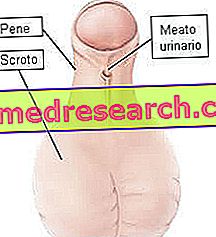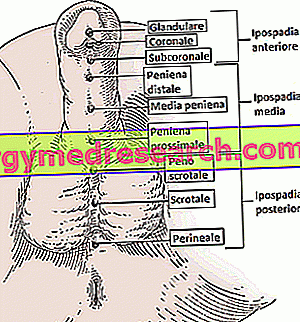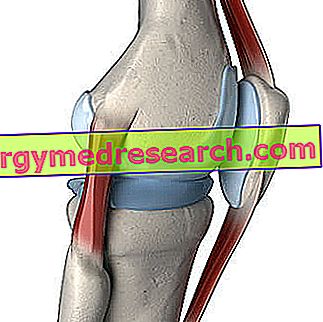Generality
Hypospadias is a congenital anomaly that alters the structure of the urethra. In affected patients, the urethral canal is shorter than normal and its opening does not reside where it should, ie at the tip of the penis.

Hypospadias requires surgery, which reconstructs the urethra and positions its opening at the tip of the penis. It is a delicate operation, but with a good success rate. It is recommended to do it in the first years of life.
Brief anatomical reference of penis and urethra
To better understand what happens in the hypospadias, it is advisable to make a brief review of the anatomy of the penis and urethra.
THE PENIS
The penis is located between the pubis and perineum. It has a cylindrical shape and is composed mainly of three structures: the body, the head and the foreskin.

Figure : main anatomical elements of the penis. From the sito concerned.it
The body consists of the two cavernous bodies, parallel to each other and placed in the dorsal fascia (upper side) of the penis, and the spongy body placed in the ventral fascia (lower side). These three structures are wrapped in connective tissue. The cavernous arteries pass through the cavernous bodies, while the urethra passes through the spongy body. At the origin of the body is the scrotum, containing the testicles.
The head corresponds to the glans, which has an opening at the tip, the so-called urinary meatus, through which urine and sperm come out. The glans is surrounded by a particular area, called the crown.
Finally, the foreskin is a layer of skin, which serves to cover the glans.
URETHRA
The urethra is a channel of about 18-20 centimeters, which originates from the bladder and serves to conduct urine outward during urination and (in humans) sperm during ejaculation. The urethra passes through the pelvic floor and the penis. In humans, its opening, or urinary meatus, resides in the glans, at the tip.
What is hypospadias
The hypospadias is an anatomical anomaly of the penis, characterized by an altered structure of the urethra and by an incorrect positioning of its opening. In fact, the canal is shorter and the urinary meatus, instead of being in the tip of the glans, occupies any point of the ventral fascia (lower side) of the penis.
Hypospadias has a congenital nature, ie it is present from birth.
TYPES OF IPOSPADIA
There are different forms of hypospadias, depending on where the opening of the urethra is located:
- Front hypospadias . It is the least severe form: the meatus is only slightly displaced with respect to normal; it may reside between the glans and the sub-crown portion.
- Medium hypospadias (or Penian ). It is the intermediate form of gravity. The opening may be located at a point between the scrotum and the subcoronal position.

- Posterior hypospadias . It is the most serious form. This category includes all the hypospadias, whose meatus is located between the scrotum and the perineum.
ASSOCIATED ANATOMICAL ANOMALIES AND INTERSEXUALITY?
The most severe forms of hypospadias are often associated with other anatomical abnormalities of the penis or urinary tract. Among these, the most frequent is the so-called congenital curved penis . However, cryptorchidism, hydrocele, inguinal hernia and renal malformations may also occur.
These associations, if present, must be taken into considerable consideration, because they could be linked to a condition of intersex, in which an individual has both male and female sexual characteristics. The causes of intersexuality include alterations of both sex chromosomes and sex hormones.
What is the congenital curved penis?
It consists of an excessive curvature of the penis, due to a lesser development of the ventral fascia of the penis and to a greater development than the dorsal one. As a result, those who suffer from it have difficulty with their erection: the penis, in fact, remains curved downwards.
The congenital curved penis, as the name suggests, is present from birth, but the patient notices it after pubertal development.
Epidemiology
The exact incidence of hypospadias is unknown: some data suggest that, to present this anomaly, both an individual every 300 new males; other statistical studies, on the other hand, speak of 2-3 patients every 300 new males.
The three forms of hypospadias occur with different frequency.
Anterior hypospadias is the most common, as it accounts for about 70% of cases.
In second place, the posterior hypospadias is positioned, with a good 20%. Moreover, this form is almost always associated with the congenital curved penis.
The last place is occupied by the average hypospadias, which affects about 10% of patients.
Causes
The exact cause of hypospadias is not currently known.
The most probable hypotheses are two: the first concerns testosterone and fetal development ; the second is related to familiarity .
FETAL DEVELOPMENT AND TESTOSTERONE
Some male sex hormones, particularly testosterone, deal with the correct formation of urethra and penis during fetal development.
In hypospadias, this fundamental process fails. We do not yet know exactly what happens. It seems that less testosterone is produced or that secreted testosterone is ineffective.
This hypothesis, which sees testosterone as a protagonist, would also explain why some cases of hypospadias (in particular the most serious ones) are characterized by intersexuality.
FAMILIARITY
According to some statistical data, 20% of hypospadias have at least one other family member with the same anomaly. Therefore, the family component plays a significant role.
OTHER RISK FACTORS
Based on the statistical data, other risk factors have been identified. They concern the mother of the future unborn child with hypospadias. These factors are shown in the table to the side.
Risk factors- Age of the mother over 40 years
- Smoke
- Exposure to chemicals (eg pesticides)
- Synthetic progesterone intake
NB: The risk related to smoking and exposure to certain chemicals requires further investigation.
Symptoms, signs and complications
To learn more: Symptoms Salpingitis
The main signs of the hypospadias concern the urethra: the canal, which constitutes it, is incomplete and the site of its opening towards the outside is in an incorrect position. Therefore, the urinary meatus does not reside in the tip of the glans, as it normally should, but is located at a different point along the ventral fascia of the penis.
The typical symptoms of hypospadias, such as:
- Difficulty urinating
- Difficult and early ejaculation
- Psychological disorders
Furthermore, the patient often suffers from another anatomical anomaly: the congenital curved penis. Together with the hypospadias, it determines:
- Difficulty of erection
- Incomplete foreskin
THE NEONATAL PHASE
Hypospadias is a congenital malformation; therefore, the patient is born with this anomaly. Nonetheless, it may go unnoticed in a careless observation of the newborn, especially if it is in mild form. In addition, children wear diapers and this helps not to notice the problem.
THE FIRST DISORDERS
In a few years, when the child begins to use the toilet, the first difficulties arise. The urination is badly oriented; therefore, the patient is forced to sit on the toilet.
FROM PUBLIC DEVELOPMENT TO THE AGE? ADULT: THE COMPLICATIONS
At the end of puberty, hypospadias has a decisive influence on patients' lives. The disorders no longer concern only urination, but also ejaculation during sexual intercourse.
Furthermore, it should not be forgotten that all these problems are amplified if the hypospadias is accompanied by the so-called congenital curved penis.
PSYCHOLOGICAL ISSUES, PSYCHOLOGICAL PROBLEMS
Once the patient becomes aware of his disorders, he may suffer from depression . In fact, he feels "different" and the difficulties encountered, both in daily life and in sexual life, increase the feeling of moral discomfort.
Diagnosis
The hypospadias is diagnosed by physical examination of the penis . Only in this way can the urologist doctor assess the position of the urinary meatus and the presence of any associated anomalies, such as the congenital curved penis and cryptorchidism.
Although hypospadias is visible from birth, it is possible that it will go unnoticed. To avoid this, it is sufficient to examine the newborn carefully.
The importance of early diagnosis is fundamental to avoid the physical and psychological repercussions faced by the adult with hypospadias.
intersex
As mentioned above, the most serious hypospadias could be linked to intersexual phenomena. To know if the patient is afflicted, genetic tests and hormonal evaluation are performed.
Therapy
Surgery is the only therapeutic treatment that can cure hypospadias. The operation is necessary for three reasons:
- Functional reason. By reconstructing the urethra and placing the urinary meatus in the correct place, the patient no longer encounters difficulties during urination.
- Sexual reason. To allow the normal erection of the penis. This aspect is very important if the patient suffers from a congenital curved penis
- Aesthetic reason. A normal appearance of the penis gives the patient confidence and eliminates any embarrassment due to sexual deficits.
WHAT IS THE AGE? IDEAL FOR OPERATING?
Surgery can be performed at any age, but the recommended one is between 4 and 18 months of life. For the following reasons: first, the post-operative course is less traumatic for a newborn (who will not remember it) than for an adult; second, the unpleasant complications afflicting the adult with hypospadias are avoided.
If you do not act in this first period of time, it is advisable to wait for the 5th-6th year of life. It has been observed, in fact, that, in children aged between 2 and 4 years, the post-operative course is difficult to manage and the psychological trauma is considerable.
WHO NEEDS INTERVENTION?
All those who have hypospadias may undergo surgery. However, the milder cases, in which the urinary meatus is displaced just below the tip of the glans, can avoid the operation. These patients can lead a normal life even without corrective intervention.
Conversely, moderate-severe cases require the operation, especially if the aforementioned anatomical anomalies are added to the hypospadias.
HOW IS THE INTERVENTION TAKEN?
The urologist surgeon reconstructs the urethral canal and the new urinary meatus, thanks to tissue taken from the buccal mucosa or the foreskin (coming from the dorsal part of the penis). In this regard, we must not overlook the following detail: we must avoid subjecting the newborn to circumcision (that is to the surgical removal of the foreskin, as a cultural gesture or for hygienic reasons) before the hypospadias operation.
The duration of the intervention can vary from one to three hours, during which the patient is subjected to general anesthesia.
The intervention techniques are very numerous; each has a particular procedure, in some cases divided into two parts. The choice of one surgical technique, rather than another, depends on the experience of the surgeon, the type of hypospadias and the shape of the penis.
Most used techniques: |
|
SUCCESS AND COMPLICATIONS OF THE OPERATION
Most hypospadias surgery (around 90%) succeeds successfully and without future complications.
However, a small percentage of cases, around 10%, is subject to urethral fistula or urethral stenosis .
The urethral fistula consists of the formation of a hole, which connects the new reconstructed urethra with the outside.
Urethral stenosis, on the other hand, is a narrowing of the new urethra, which prevents the passage of urine.
Faced with these complications, it is necessary to carry out a second operation.
Factors that affect the success of the intervention: |
|
POST-OPERATIVE ASSISTANCE
Patients are discharged after a day of hospitalization, but need prolonged post-operative care (especially the smaller ones), which can also be several tens of days long. The assistance measures consist of:
- Application of a catheter . The catheter is essential to drain the urine, contained in the bladder, during the first 10 days following the operation. Without it, prayer would not be possible.
- Wound dressing . It requires the penis to be bandaged and immobilized for a few days, to prevent infections and allow the tissues to heal.
After surgery, it is normal to suffer a slight loss of blood and urine. Instead, it must alarm the appearance of pus, fever and reddening of the skin: this means that an infection is in progress. In these situations, it is advisable to consult a doctor.
Finally, for 2-3 months it is advisable not to compress the affected area and not use the bicycle.
Prognosis
The good percentage of success of the intervention and the benefits, which derive from it, ensure that the prognosis of hypospadias is positive. Conversely, an untreated hypospadias negatively influences the standard of living.
As mentioned, the intervention performed at a young age is less traumatic than that performed on the adult. On the other hand, a child needs more careful post-operative care.
Excluding these differences, however, the anatomical anomaly is resolved in the same way and with the same success rate.
The most serious cases deserve a different discourse: in addition to presenting other anatomical malformations of the penis and urinary tract, they are characterized by intersexuality. For these patients, both surgery (to resolve hypospadias and associated diseases) and testosterone-based hormone therapy are recommended.




